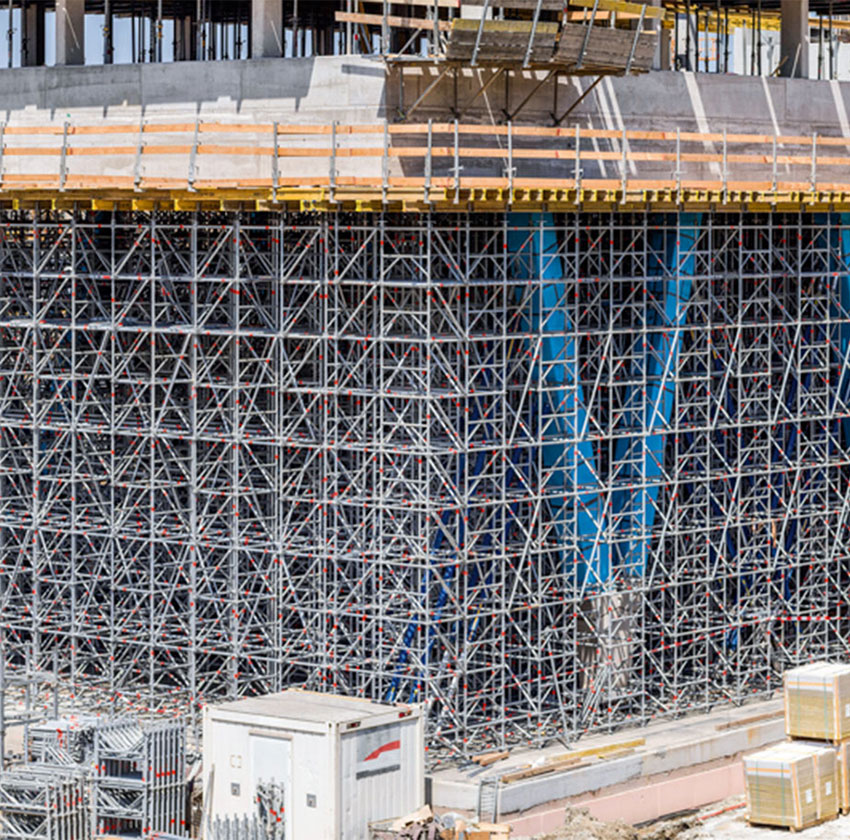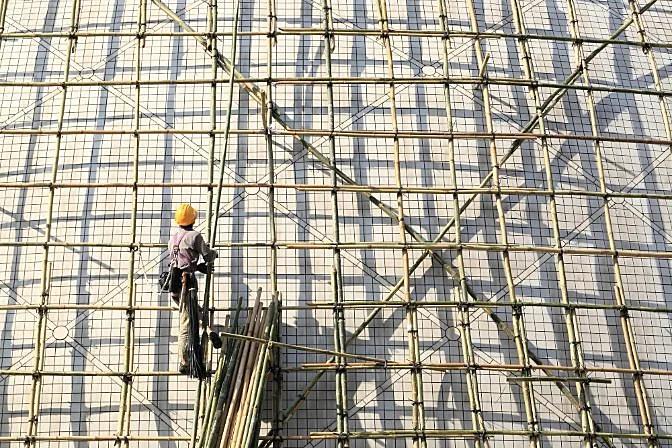Safe and Durable Scaffolding Guildford for Your Upcoming Construction Work
Wiki Article
Discovering the Various Types of Scaffolding Made Use Of in Building And Construction Jobs
The building and construction market depends heavily on various kinds of scaffolding to satisfy particular task requirements, each offering unique advantages and applications. Typical frame scaffolding gives a strong structure for basic tasks, while put on hold scaffolding is crucial for work with skyscraper structures. Various other choices, such as system and rolling scaffolding, cater to effectiveness and wheelchair, respectively. The cantilever alternative proves very useful in metropolitan settings where room is constrained. Understanding the nuances of these scaffolding types is essential for optimizing safety and performance on building and construction sites, motivating a more detailed evaluation of their special qualities and applications.
Standard Structure Scaffolding
Standard structure scaffolding is one of one of the most commonly utilized techniques in the building and construction industry due to its toughness and versatility. This system includes upright and straight frameworks that are put together to produce a stable system for products and employees. The major elements consist of vertical articles, straight ledgers, and diagonal braces, which together provide a strong framework that can sustain considerable loads.Among the vital advantages of conventional frame scaffolding is its versatility to different construction tasks, ranging from property structures to large industrial frameworks. The modular layout permits for easy assembly and disassembly, making it effective for both lasting and temporary tasks. In addition, the system can be personalized in elevation and width, suiting different structure styles and site problems.
Safety and security is vital in scaffolding applications, and conventional frame systems are geared up with guardrails and toe boards to protect against falls and make certain worker defense. Additionally, routine inspections and adherence to security laws are important in preserving the integrity of the scaffold. Generally, traditional frame scaffolding continues to be an essential selection in the building and construction market, providing a trusted system for labor and boosting general job effectiveness

Suspended Scaffolding
Put on hold scaffolding uses a special service for building and construction projects that require accessibility to elevated surface areas, specifically in circumstances where typical structure scaffolding may be impractical. This kind of scaffolding is generally suspended from the roofing system or top levels of a framework, using a system of wheels, platforms, and ropes to develop a working space that can be adapted to different heights.Among the primary benefits of suspended scaffolding is its flexibility. It can be quickly rearranged or lowered to fit changes in building and construction demands, making it optimal for jobs such as home window setup, frontage work, and upkeep on skyscrapers. Additionally, the very little footprint of put on hold scaffolding permits for better use ground room in metropolitan settings, where room is commonly limited.
Security is a critical consideration in the use of put on hold scaffolding. Correct rigging and anchoring systems need to be employed to guarantee stability and stop accidents. Operators has to additionally be educated in the secure use this devices. Overall, suspended scaffolding gives a reliable and efficient solution for accessing hard-to-reach locations in numerous construction circumstances, improving both productivity and safety on site.
System Scaffolding
System scaffolding, usually considered a contemporary service in the scaffolding market, includes pre-engineered parts that can be rapidly put together and adapted for numerous building and construction jobs. Scaffolding. This kind of scaffolding is characterized by its modular layout, which allows for versatility and effectiveness on job websites, accommodating various heights and architectural requirementsUsually made from high-strength steel or light weight aluminum, system scaffolding supplies enhanced longevity and stability. The elements consist of upright articles, horizontal journals, and angled braces, which interconnect safely, guaranteeing a robust structure. The design usually includes standard fittings, simplifying assembly and disassembly processes, consequently reducing labor time and costs.

Rolling Scaffolding
Rolling scaffolding is a functional Local scaffolding company choice to standard fixed scaffolding, developed for movement and convenience of usage on building websites. This sort of scaffolding includes a system sustained by frameworks with wheels, allowing employees to quickly move it as required. The flexibility function dramatically improves performance, as it decreases downtime related to disassembling and putting together fixed scaffolding.Commonly created from light-weight materials such as aluminum or steel, rolling scaffolding uses a sturdy yet portable service for projects needing frequent repositioning - Scaffolding. It is particularly helpful in jobs such as paint, drywall setup, and electric work, where access to various elevations and locations is necessary
Safety is vital in rolling scaffolding layout, with features such as locking wheels to prevent unintentional activity when in operation, and guardrails to protect employees from falls. Furthermore, lots of versions are adjustable in height, suiting different job requirements.
Cantilever Scaffolding

The style of cantilever scaffolding usually entails making use of braces or arms secured to a structure or structure, enabling the platform to extend outward securely. Safety is vital; therefore, these scaffolds should be crafted to endure ecological problems and various lots. Normal assessment and upkeep are essential to ensure architectural integrity and employee security.
Cantilever scaffolding is preferred for its adaptability and efficient usage of area, making it a prominent selection in metropolitan environments where area constraints prevail. It promotes simpler accessibility to high altitudes, inevitably adding to the general performance of building tasks. As with all scaffolding types, appropriate training and adherence to safety requirements are crucial for employees using cantilever scaffolding.
Verdict
To conclude, the varied kinds of scaffolding utilized in building and construction jobs each offer distinctive objectives customized to details site needs. Conventional structure scaffolding gives security, while put on hold scaffolding offers flexibility for elevated tasks. System scaffolding assists in fast assembly, and rolling scaffolding improves wheelchair for differing workplace. Cantilever scaffolding effectively attends to barriers in urban setups. Recognizing these scaffolding types is crucial for maximizing safety and security and performance in construction, eventually adding to the successful completion of jobs.Traditional frame scaffolding gives a strong foundation for general jobs, while suspended scaffolding is necessary for work on high-rise frameworks.Rolling scaffolding is a versatile alternative to traditional fixed scaffolding, made for wheelchair and ease of use on building websites. As with all scaffolding types, correct training and adherence to safety standards are crucial for employees using cantilever scaffolding.
Typical structure scaffolding offers security, while suspended scaffolding provides versatility for elevated tasks. System scaffolding helps with fast setting up, and rolling scaffolding boosts movement for differing work environments.
Report this wiki page